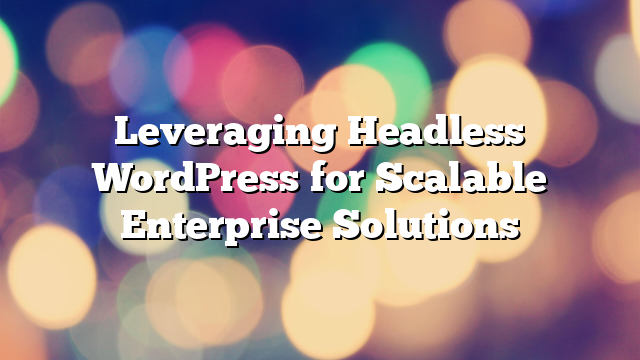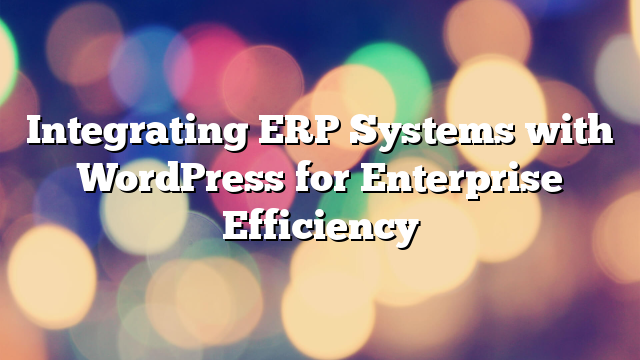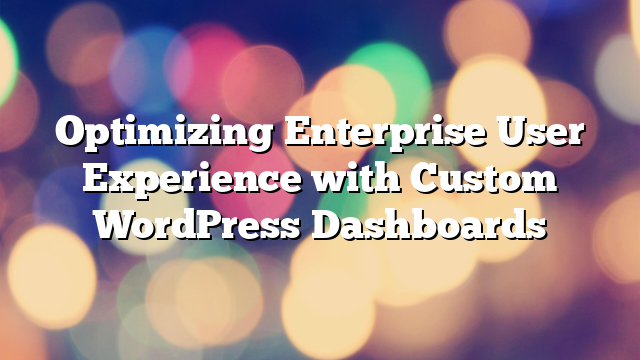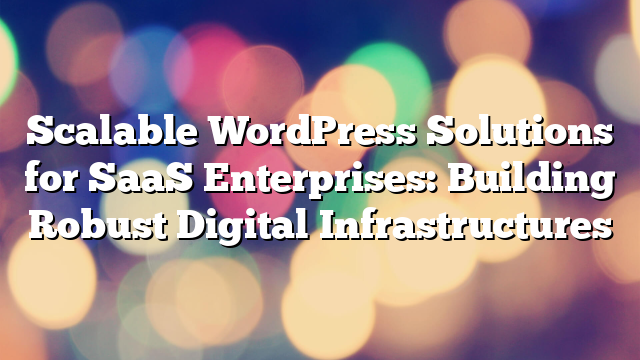Leveraging Headless WordPress for Scalable Enterprise Solutions
11.01.2025

In the rapidly evolving world of web development, businesses are seeking more flexible, scalable, and performance-driven solutions for their websites. One of the most promising approaches for enterprise-level solutions is Headless WordPress. By decoupling the front-end from the back-end, Headless WordPress allows businesses to build websites and applications that are faster, more flexible, and scalable. In this article, we’ll explore how Headless WordPress can benefit your enterprise and how it enables a powerful, dynamic user experience.
What is Headless WordPress?
Headless WordPress refers to the practice of using WordPress only as the back-end content management system (CMS), while the front-end of the site is handled separately. Instead of using WordPress’s built-in theme system, developers can use any technology they prefer for the front-end, such as React, Next.js, or Vue.js. WordPress then serves content via APIs, allowing full control over the user interface while maintaining the content management capabilities of WordPress.
This approach makes WordPress a flexible, content-centric platform that can be used in a variety of ways to power websites, mobile apps, and even IoT devices. Let’s dive into the main benefits of using Headless WordPress for enterprise websites.
1. Flexibility in Front-End Development
One of the key advantages of Headless WordPress is the freedom it provides developers in terms of front-end technologies. Traditional WordPress relies on PHP-based themes for the front-end, which can be limiting when it comes to performance and design flexibility. With Headless WordPress, developers can choose from a wide array of modern front-end frameworks, such as Next.js, React, or Angular, to create custom and dynamic user interfaces.
This flexibility allows businesses to adopt cutting-edge front-end technologies that can improve performance, offer rich user experiences, and stay ahead of digital trends. Additionally, this separation of concerns means that front-end developers and back-end developers can work in parallel, streamlining development processes and improving productivity.
2. Enhanced Performance and Speed
Performance is a critical factor for enterprise websites. Slow-loading pages can result in high bounce rates, poor user experience, and lower search engine rankings. With Headless WordPress, websites can leverage technologies like server-side rendering (SSR) and static site generation (SSG) to improve load times significantly.
For example, Next.js, a popular framework for building modern web applications, supports SSR and SSG, which can deliver content to users much faster than traditional WordPress sites. By serving pre-built pages directly from the server or CDN, Headless WordPress websites can dramatically reduce page load times and ensure a smoother browsing experience for users.
3. Scalability for Growing Businesses
As your business grows, so do your website’s traffic and complexity. Traditional WordPress setups can become sluggish and difficult to scale as the number of users and content increases. Headless WordPress offers an ideal solution for scalability, allowing businesses to scale both the front-end and back-end independently.
Because the front-end and back-end are decoupled, enterprises can scale their infrastructure to handle increased traffic without disrupting the content management system. Additionally, Headless WordPress can be integrated with content delivery networks (CDNs), which can further enhance performance and scalability by distributing content across multiple servers globally.
4. Omnichannel Content Delivery
With the rise of multiple platforms—such as mobile apps, websites, smart devices, and more—businesses are increasingly looking for ways to deliver consistent content across all channels. Headless WordPress makes it easier to deliver content to a wide variety of platforms, thanks to its API-first approach.
For instance, an enterprise website built with Headless WordPress can serve content not only to the website itself but also to mobile applications, smartwatches, voice assistants, or even IoT devices. This omnichannel content delivery ensures that users have a consistent experience across all touchpoints, without the need for separate systems or content management tools for each platform.
5. Greater Security and Control
Security is always a top priority for enterprise websites, especially when dealing with sensitive customer data and transactions. Headless WordPress offers enhanced security compared to traditional WordPress sites due to its decoupled nature. By separating the front-end from the back-end, Headless WordPress reduces the number of attack surfaces, making it harder for hackers to gain access to the system.
Additionally, since the front-end is not directly tied to WordPress’s PHP-based back-end, it’s less vulnerable to common threats like cross-site scripting (XSS) or SQL injection attacks. The use of modern frameworks for the front-end also means that security measures can be applied at every layer, ensuring a robust security posture for the entire website.
6. Future-Proofing Your Enterprise Website
As technologies evolve, businesses need solutions that can adapt to new requirements and digital trends. Headless WordPress offers the flexibility to integrate with emerging technologies and platforms without needing to overhaul the entire system. This makes it an excellent choice for enterprises looking to future-proof their websites.
For example, Headless WordPress can integrate with artificial intelligence (AI), machine learning (ML), augmented reality (AR), and other advanced technologies. By using APIs, enterprises can connect their websites to innovative tools that enhance user experiences, streamline operations, or improve decision-making processes. With Headless WordPress, businesses can stay ahead of technological advancements without being tied to a traditional content management system.
7. Better Developer Experience
For developers, Headless WordPress provides a more modern and flexible development environment. With the front-end and back-end decoupled, developers can work with the tools and frameworks they’re most comfortable with, using JavaScript, React, Vue.js, or other modern technologies. This creates a more seamless and efficient development process, as teams can focus on specific tasks without worrying about limitations imposed by traditional WordPress themes.
Furthermore, Headless WordPress websites are easier to maintain and update, as the front-end and back-end are independent. This allows for faster iteration and deployment cycles, ensuring that your website remains up-to-date with minimal downtime.
Conclusion
Headless WordPress is an excellent solution for businesses looking to scale, improve performance, and provide a more flexible, secure, and dynamic digital experience. By decoupling the front-end and back-end, enterprises can take full advantage of modern web technologies while maintaining the powerful content management capabilities of WordPress. Whether you’re delivering content across multiple platforms, improving site performance, or future-proofing your website, Headless WordPress offers a robust solution to meet your enterprise needs.
If you’re ready to explore how Headless WordPress can elevate your enterprise website, contact AllWebDev today for expert guidance and implementation support.



